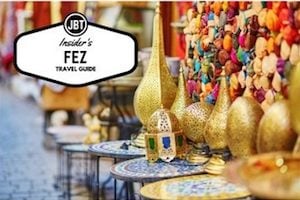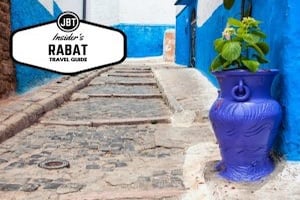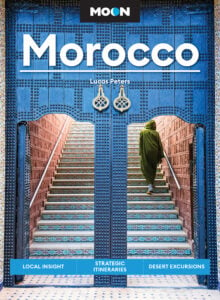Fez, one of Morocco’s most enchanting cities, is a treasure trove of cultural heritage. Steeped in history and boasting a rich tapestry of architectural wonders, Fez has been recognized by UNESCO for its exceptional universal value as early as 1981. For amateurs of history, architecture, crafts and arts alike, the several Fez UNESCO World Heritage sites are very well deserving of a spot on any bucket list.
While visiting Fez, you will embark on a journey through time and explore the UNESCO World Heritage Sites of Fez, shedding light on their significance and inviting you to immerse yourself in the magic of this ancient Moroccan gem, once one of the biggest Islamic metropolis’s in the world with varying architectural landscapes.
The ancient section of the Medina of Fez, encompassing numerous monumental structures, safeguards the historical legacy of the capital city established by the Idrisid dynasty between 789 and 808 A.D. Originally, the city was divided into two fortified quarters along the banks of the Andalusian and Kaïrouani districts. In the 11th century, the Almoravids united the city within a single rampart, and during the reign of the Almohads in the 12th and 13th centuries, the original town, Fez el-Bali, had already expanded to its present size.
During the Merinid era from the 13th to the 15th centuries, a new town called Fez Jedid was established in 1276 to the west of the ancient city. Fez Jedid encompassed the royal palace, army headquarters, fortifications, and residential areas. At this time, the two entities of the Medina of Fez coexisted symbiotically, forming one of the largest Islamic metropolises characterized by a diverse array of architectural styles and urban landscapes. The medina showcased a multitude of religious, civic, and military monuments, fostering a multicultural society.

The architecture of Fez’s Medina reflects construction techniques and ornamentation developed over more than ten centuries, blending local knowledge and skills with various external influences, including Andalusian, Oriental, and African inspirations. This amalgamation of styles resulted in a rich tapestry of architectural forms, creating a unique and captivating ambiance throughout the Medina of Fez.
It has acquired its UNESCO Protected World Heritage status mainly because of two main criteria:
A place to exhibit an important interchange of human values, over a span of time or within a cultural area of the world, on developments in architecture or technology, monumental arts, town-planning or landscape design:
Regarded as an expansive and remarkably well-preserved historical city, the Medina of Fez holds a distinguished position among the Arab-Muslim world. This urban space, characterized by its unpaved pathways, has managed to retain the majority of its original functions and characteristics. Beyond its architectural, archaeological, and urban significance, the Medina also embodies a way of life, expertise, and a culture that persist and evolve, despite the diverse influences and impacts it has encountered throughout its existence. It is also recognized for its authenticity, integrity and for having met various protection and management requirements.

To be an outstanding example of a traditional human settlement, land-use, or sea-use which is representative of a culture (or cultures), or human interaction with the environment especially when it has become vulnerable under the impact of irreversible change:
The Medina of Fez stands as a vibrant testament to a once-thriving city in the eastern Mediterranean that exerted significant influence, particularly from the 12th to the 15th centuries. From the moment you enter through Bab Boujloud, you’ll notice Its impact on architecture, monumental arts, and urban design is notable, extending to regions such as North Africa, Andalusia, and Sub-Saharan Africa. Fez Jedid, the newer part of the city, drew inspiration from the earlier town-planning model seen in Marrakesh. The several Fez UNESCO World Heritage sites make for an unforgettable experience.

Don’t miss these Fez UNESCO World Heritage landmarks during your visit!
Fez Medina:
At the heart of Fez lies its pulsating soul, the Medina of Fez, a sprawling labyrinth of narrow streets, bustling markets, and timeless beauty. Recognized as a UNESCO World Heritage Site in 1981, the Medina is a living testament to the city’s past glory. Its network of over 9,000 alleys transports visitors to a bygone era, where artisans practice age-old crafts, and historical sites unfold at every corner. This ancient walled city comprises three main sections: Fes el Bali, Fes el Jdid, and the Jewish Quarter (Mellah).
Fes el Bali, the oldest part of the Medina, is a vibrant hub of activity. Its labyrinthine alleys, known as “derbs,” wind their way past traditional workshops, artisanal stalls, and centuries-old buildings. Exploring the Medina’s streets reveals hidden gems like the Moulay Idriss II Mausoleum, the Fez Tanneries the Fondouk Nejjarine, and the Al-Attarine Medersa, Jnan Sbil gardens and Dar Batha Museum.
Fes el Jdid, the newer section, showcases the city’s evolving architectural styles. Notable landmarks include the Royal Palace with its magnificent bronze doors and the Merinid Tombs, offering panoramic views of the city.
The Mellah, Fez’s Jewish Quarter, showcases the coexistence of cultures within the Medina. Visitors can explore the historic Jewish cemetery, synagogues, and a renowned museum dedicated to Jewish heritage.

Al-Qarawiyyin Library
Adjacent to the Qarawiyyin Mosque lies a hidden gem, the Al-Qarawiyyin Library— established in the 9th century by Fatima Al-Fihri as part of Al-Qarawiyyin University. It holds the title of the oldest library in the world still in use. With its priceless collection of ancient manuscripts and religious texts, the library is a testament to Fez’s long-standing intellectual legacy. Scholars and visitors alike are captivated by the calligraphy, beautifully illustrated pages, and the sheer wealth of knowledge housed within its walls.
The library’s architecture is a fusion of Andalusian, Moorish, and Moroccan styles, with beautiful courtyards, ornate arches, and precise woodwork. The reading rooms are adorned with traditional Islamic calligraphy and delicate geometric patterns.
Visitors to the library can marvel at rare manuscripts, some dating back centuries, and gain insights into various fields of study, including Islamic law, astronomy, medicine, and literature. The library also serves as a center for academic research and hosts cultural events and lectures.
Medersa Bou Inania:
Medersa Bou Inania is a captivating architectural gem located within the ancient Medina of Fez. Built in the 14th century by Sultan Abu Inan Faris, this grand Islamic school showcases the exquisite craftsmanship and artistic brilliance of the Marinid dynasty.
As you step through its magnificent entrance, you are greeted by a stunning courtyard adorned with interlaced geometric patterns, carved plasterwork, and zellij tilework. The central courtyard features a mesmerizing marble fountain, enhancing the tranquil ambiance. The walls of the madrasa are embellished with delicate stucco plasterwork and inscriptions from the Quran, showcasing the mastery of the artisans of the time.
Inside the madrasa, you can explore the student dormitories, which are decorated with ornate wooden carvings and beautifully painted ceilings. The prayer hall is a true marvel, with its grand arches, finely carved columns, and a stunning mihrab (prayer niche). The mihrab is adorned with vibrant mosaic tiles and intricate calligraphy, reflecting the importance of spirituality and religious devotion.

Medersa Attarine:
Medersa Attarine is another architectural masterpiece located in the heart of the Medina of Fez. Founded in the 14th century, it is renowned for its exceptional beauty and attention to detail.
Upon entering Madrasa Attarine, you are greeted by a small courtyard that leads to the main courtyard, which serves as the focal point of the madrasa. The courtyard is a visual feast, featuring an intricately carved marble fountain and a symphony of colors created by the zellij tilework. The arches, columns, and walls are adorned with calligraphy, showcasing the skilled craftsmanship of the period.
As you explore the student cells, you will notice the meticulous design and decoration that creates a serene and conducive environment for learning. The woodwork, including carved cedar ceilings and doors, adds to the charm and elegance of the space.
Madrasa Attarine also houses a small museum where you can admire artifacts and exhibits that provide insights into Islamic art, calligraphy, and historical manuscripts.

Dar al-Magana Clock
Adjacent to the Qarawiyyin Mosque lies a hidden gem, the Al-Qarawiyyin Library— established in Nestled in the heart of the Medina, the Dar al-Magana Water Clock is a remarkable historical landmark. Built in the 14th century, this innovative clock utilized a complex system of water and weights to mark the passing hours. Though the clock is no longer functional, its architecture and design continue to impress visitors. The structure features a large stone basin, from which water once flowed, powering the clock mechanism. Intricate carvings and inscriptions adorn the surrounding walls, adding to its allure.
Borj Nord and Borj Sud
Standing proudly on the hills overlooking Fez, The Borj Nord and Borj Sud are imposing fortresses. Built in the 16th century, these defensive structures played a significant role in protecting the city.
Borj Nord, also known as Borj An-Nord, offers panoramic views of the Medina and its surroundings. It houses a small museum showcasing ancient weapons, traditional Moroccan costumes, and historical artifacts. Visitors can climb its towers and imagine the strategic importance it held in defending Fez.
Borj Sud, or Borj Jdid, features impressive ramparts and terraces, allowing visitors to appreciate the city’s architectural beauty from a different perspective. It also provides insights into Fez’s military history
These UNESCO World Heritage Sites in Fez collectively represent the city’s rich history, Islamic cultural traditions, and architectural brilliance. Exploring these sites allows visitors to delve into the fascinating heritage of Fez while experiencing the vibrant atmosphere of one of Morocco’s most iconic cities. Some traditional pottery items or a leather babouche (also known as Belgha) will make for great souvenirs!

Fez’s UNESCO World Heritage Sites weave together the fabric of Morocco’s cultural and historical tapestry. From the mesmerizing Medina and its iconic landmarks to the ancient Al-Qarawiyyin Library and the remnants of past fortresses, Fez offers an immersive experience that transcends time. Exploring these sites not only enriches our understanding of Fez’s past but also deepens our appreciation for the contributions of Islamic civilization and its enduring legacy. So, step into Fez and let the whispers of history guide you through its UNESCO heritage sites, for they are the windows to an ancient and captivating world.
About the Author

Omar is an American-Moroccan who grew up in Washington DC before moving to Morocco, where he has lived in a few different places including Fez, Meknes, Ifrane and Rabat. Omar always keeps one foot in each country and is very comfortable navigating through both cultures. Omar currently lives in Rabat working in the development sector and pens the occasional deep-dive travel article. He has been working with Journey Beyond Travel since 2022, where he leverages his know-how to help travelers plan the trip of a lifetime… and a few of his own journeys as well.









